A self-contained working coconut plantation, It was founded in the 1880s by Don Placido Escudero and his wife Dona Claudia Marasigan. Originally planted to sugarcane, the crop was converted to coconut by their son Don Arsenio Escudero in the early 1900s. A pioneering agro-industrialist, he built the country's first working hydroelectric plant to supply his dessicated coconut factory and Villa Escudero, where he and his wife Dona Rosario Adap built in 1929.
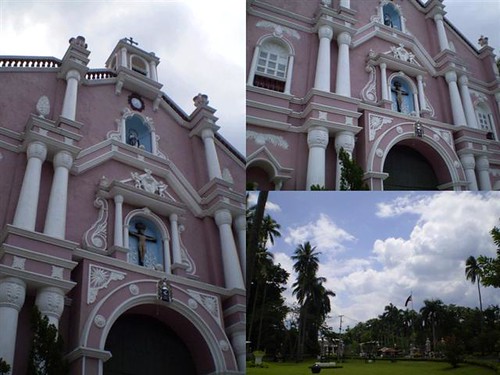
The Museum housing the Escudero Family's Santo Collection, from what I heard this is just phase 1, Don Ado Escudero is still planning to have another museum featuring carroza's
Their children opened the estate to the public in 1981. From its humble beginnings, the resort has become a prime tourist destination for locals, overseas Filipinos and a wide array of foreign visitors to the country. It has a worldwide reputation as a showcase for the Philippines' rich cultural heritage, offering a beguiling glimpse of its history, cuisine, dress, customs and natural beauty a mere two hours away from Manila. Villa Escudero, text taken from its homepage.
There's much to see in this vast nature reserve, including shows featuring traditional Filipino dances, dining in a restaurant near a beautiful waterfalls, tour of a rural village etc...however since I am more of a Santo Enthusiast than a culture and nature tripper, I am focusing, for now, on the immense "santo" collection well kept in the confines of this park.
First Stop, the Santo's in the Museum

The AERA Memorial Museum, founded by spouses Arsenio and Rosario Escudero, houses one of the largest collections in the country, unmatched in its eclectic diversity. Housed in a replica of a long-gone church in Intramuros with painted trompe-l'oeil ceilings, the present building opened for viewing in 1987. The core of the collection is its trove of colonial religious art. The superbly executed silver altars, gilded carrozas, ivory santos, embroidered vestments and intricately carved inages and bas-reliefs and tableaux, most dating from the Spanish colonial era are a testimony to the artistry and piety of the Filipino. Reflecting a lifetime of dedicated collecting and the wide-ranging interest of the Escudero couple, there are also extensive collections of Oriental ceramics, natural history and ethnographic dioramas, costumes, household furniture, weaponry and many other items of interest collected in their travels around the world.
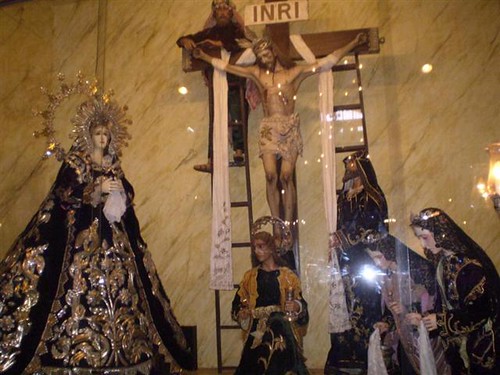
Tableau of the Descent of the Cross, a famous processional tableau in the "Philippine Santo World" primarily because of the huge Ivory Mater Dolorosa. This image participates in the Holy Week Procession of San Pablo Laguna (Private).

From L-R: 2 versions of the Mater Dolorosa, 3 versions of the suffering Christ: Carrying of the Cross, the Paciencia or Crowning with Thorns and the (third) fall of Jesus Christ

From L-R: The Last Supper, The Calandra and the Dolorosa, Santa Salome on top of a Silver Chariot and another Triunfal Carroza with the image of the Agony in the Garden on top...if I am not mistaken this is the carroza of Our Lady of the Rosary of San Pablo, given that at the front of the carroza you'll notice the A/M logo a Marian symbol
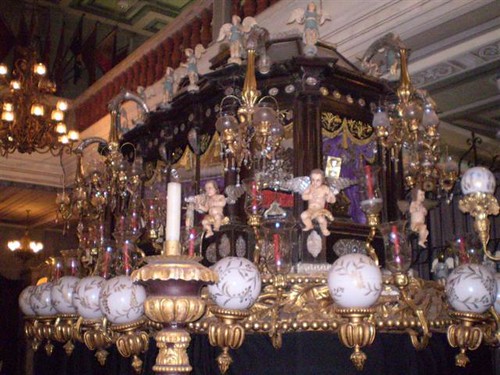
A huge Calandra with beautiful angel and Papaya details and painted "globos"

Another view of the Calandra, wherein you can see the image of the Santo Entierro

From L-R: The Mater Dolorosa and the Carrying of the Cross
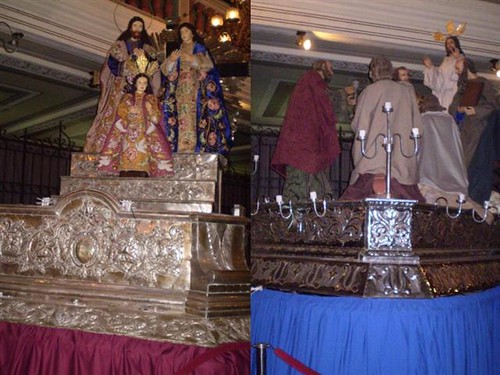
From L-R: The Holy Family and the Last Supper, both on top of beautiful silver carroza;s
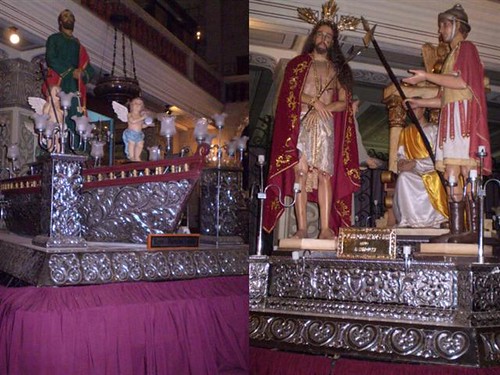
From L-R: St. Peter and the Ecce Homo (Presentation of Jesus to the Crowd)
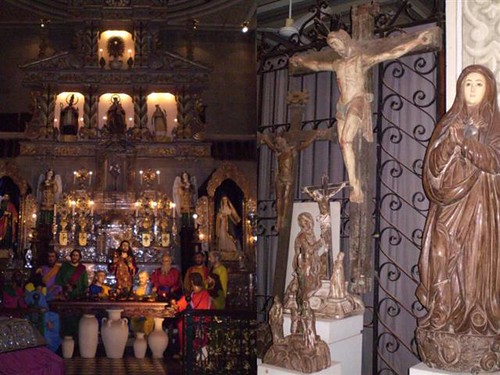
From L-R: Another Last Supper tableau in front of an actual church retablo, recovered and restored for the museum; a collection of folksy table top religious images of Christ and the Virgin
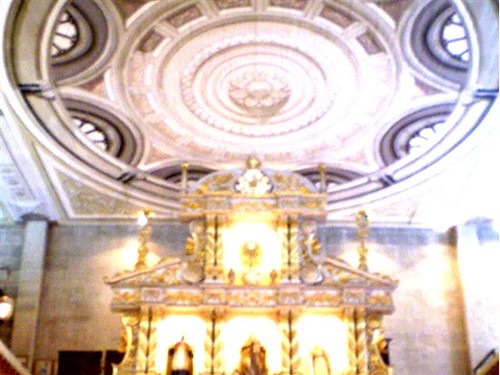
A painted ceiling which gives you a 3D architecture feel crowning the retablo...

The images on the Church Retablo, If I am not mistaken these are San Agustin, Our Lady of Mt. Carmel and either Santa Alexandria or Santa Ursula because of the sword...note also the exquisite monstrance at the top most part...
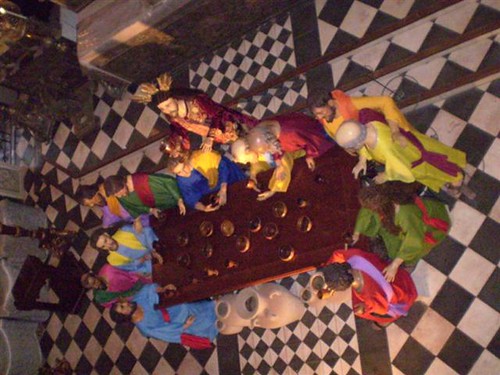
Another look at the Last Supper, beautiful staging of the scene...I can't stop myself from using beautiful, it really best describes everything in this museum...

A priest seemingly in the act of veneration...part of the retablo section of the exhibit
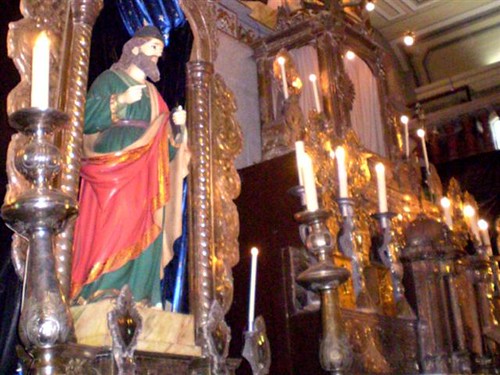
An unknown saint in one of the side altars near the retablo...

From L-R: Ladies in deep purple: the Mater Dolorosa and Santa Salome

From L-R: Another look at the Agony in the Garden and the Mater Dolorosa on her "Lusutan" carroza with Papaya details and painted "Globos"
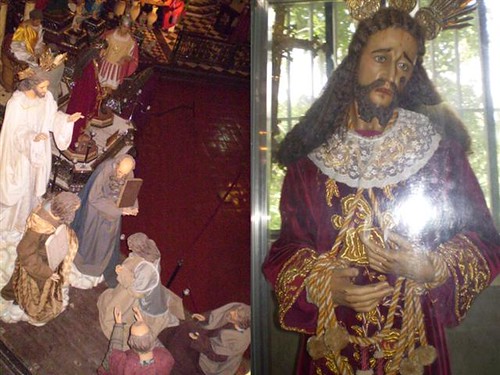
From L-R: The Transfiguration and the Cautivo (the Captive Christ)
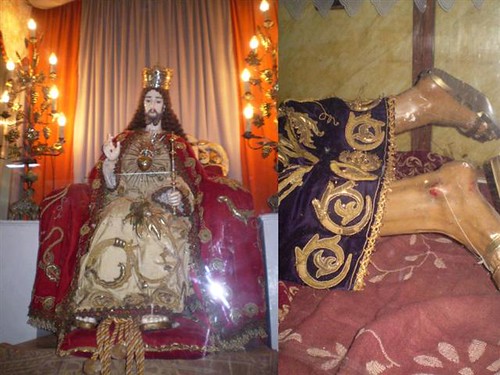
Gold slippers or sandals for Jesus...From L-R: Christ the King and the feet of Jesus from the Third Fall tableau

A collection of images of Mary and of the Saints inside Urna's
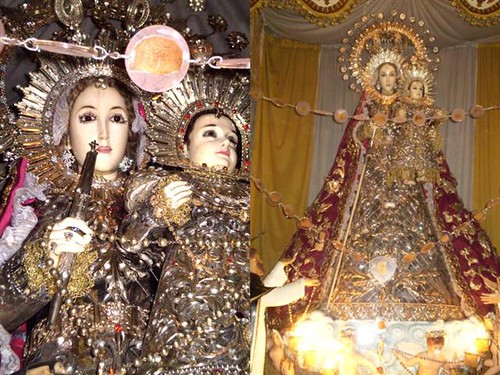
The Santo Rosario of San Pablo, Laguna

The Ivory Mater Dolorosa from the Descent from the Cross tableau...the lace band on her head bemuse me
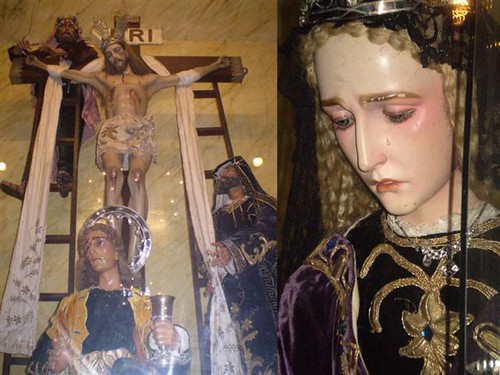
the other images comprising the Descent tableau...
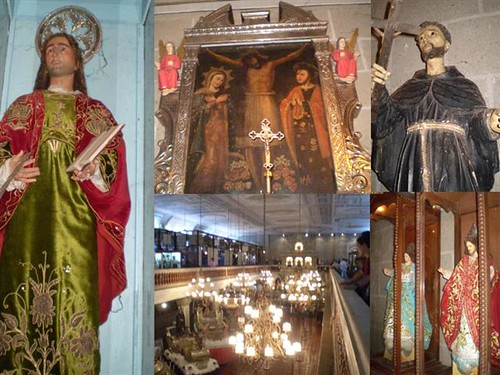
From L-R: St. John the Beloved, a painting of the Crucifixion with Mary and John, View from the 2nd floor of the Museum, St. Francis of Assisi and the Twin Hearts inside Urna's

More memorabilias and Santo's...

A Dolorosa or Santa Helena?
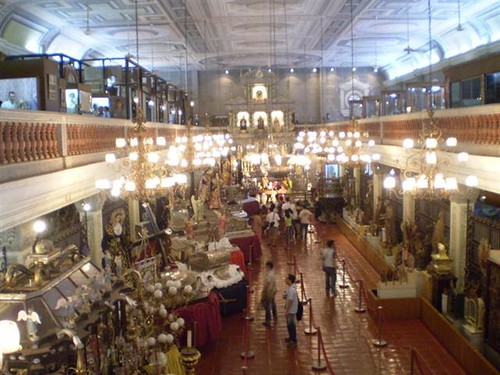
A last look before exiting the 2nd floor...
Moving on to the Second Stop: the Church of the Ascension
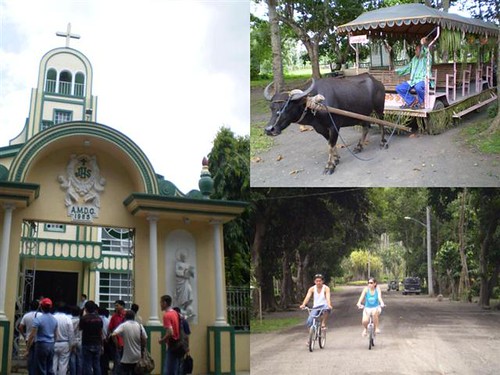
To get to the chapel from the museum you have four options: ride a colorful jeepney (not your typical Manila jeepney) or a carabao driven carriage, walk or ride a bicycle (which is a bit romantic I should say...)
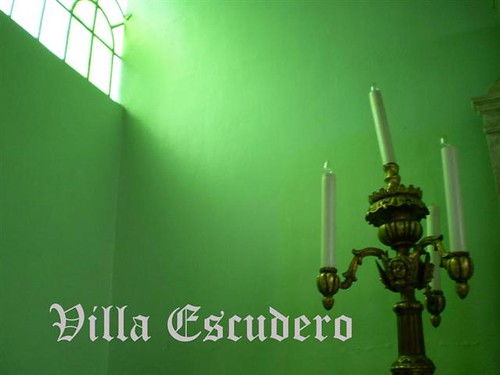
And so when they had come together, they were asking Him, saying, “Lord, is it at this time You are restoring the kingdom to Israel?” He said to them, “It is not for you to know times or epochs which the Father has fixed by His own authority; but you shall receive power when the Holy Spirit has come upon you; and you shall be My witnesses both in Jerusalem, and in all Judea and Samaria, and even to the remotest part of the earth. And after He had said these things, He was lifted up while they were looking on, and a cloud received Him out of their sight. And as they were gazing intently into the sky while He was departing, behold, two men in white clothing stood beside them; and they also said, “Men of Galilee, why do you stand looking into the sky? This Jesus, who has been taken up from you into heaven, will come in just the same way as you have watched Him go into heaven”

The church altar. During the Feast of the Ascension, an image of the Resurrected Christ is processed around Villa Escudero, the image is also enthroned here
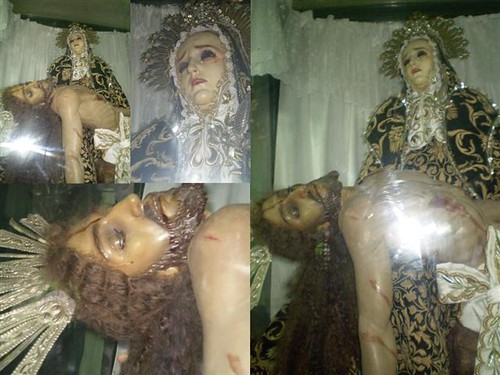
Another famous Villa Escudero image, the Pieta. I first saw this image in the Cuaresma book. It is a wonder to behold...

Another look at the Pieta, depicting the body of Jesus on the lap of his mother Mary after the events of the Crucifixion

The church images, not as vast as the museum but nonetheless remarkable...said to be works of the Filipino masters of the old world
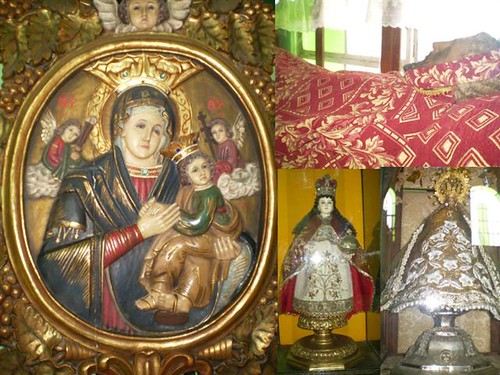
From L-R: Mother of Perpetual Help, the Santo Entierro, Santo Nino and Our Lady of Caysasay
More religious Images
At the back of the church is the Family mausoleum...

The Fifth Glorious Mystery, the Coronation of Mary as Queen of Heaven and Earth on the facade of the Family mausoleum. A similar image (in wood) can also be seen inside the museum, probably this image on the Mausoleum was inspired from that image.
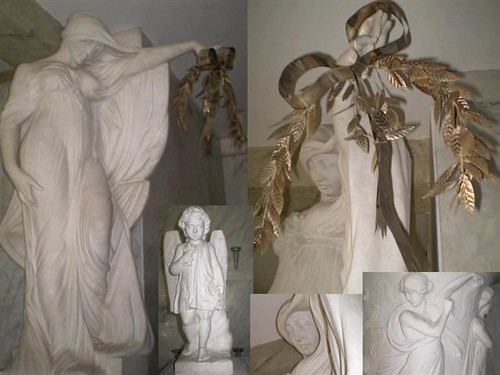
Inside the Mausoleum...although not religious images, I can't help but be amazed in these beautiful marble sculptures, graceful and elegant...truly a befitting resting place for the Escudero clan
Inside one of the Guest Houses...

La Paloma, a beautiful Marian image which used to join the Intramuros Grand Marian Procession

More images of saints and Christ

The Museum housing the Escudero Family's Santo Collection, from what I heard this is just phase 1, Don Ado Escudero is still planning to have another museum featuring carroza's
Their children opened the estate to the public in 1981. From its humble beginnings, the resort has become a prime tourist destination for locals, overseas Filipinos and a wide array of foreign visitors to the country. It has a worldwide reputation as a showcase for the Philippines' rich cultural heritage, offering a beguiling glimpse of its history, cuisine, dress, customs and natural beauty a mere two hours away from Manila. Villa Escudero, text taken from its homepage.
There's much to see in this vast nature reserve, including shows featuring traditional Filipino dances, dining in a restaurant near a beautiful waterfalls, tour of a rural village etc...however since I am more of a Santo Enthusiast than a culture and nature tripper, I am focusing, for now, on the immense "santo" collection well kept in the confines of this park.
First Stop, the Santo's in the Museum

The AERA Memorial Museum, founded by spouses Arsenio and Rosario Escudero, houses one of the largest collections in the country, unmatched in its eclectic diversity. Housed in a replica of a long-gone church in Intramuros with painted trompe-l'oeil ceilings, the present building opened for viewing in 1987. The core of the collection is its trove of colonial religious art. The superbly executed silver altars, gilded carrozas, ivory santos, embroidered vestments and intricately carved inages and bas-reliefs and tableaux, most dating from the Spanish colonial era are a testimony to the artistry and piety of the Filipino. Reflecting a lifetime of dedicated collecting and the wide-ranging interest of the Escudero couple, there are also extensive collections of Oriental ceramics, natural history and ethnographic dioramas, costumes, household furniture, weaponry and many other items of interest collected in their travels around the world.

Tableau of the Descent of the Cross, a famous processional tableau in the "Philippine Santo World" primarily because of the huge Ivory Mater Dolorosa. This image participates in the Holy Week Procession of San Pablo Laguna (Private).

From L-R: 2 versions of the Mater Dolorosa, 3 versions of the suffering Christ: Carrying of the Cross, the Paciencia or Crowning with Thorns and the (third) fall of Jesus Christ

From L-R: The Last Supper, The Calandra and the Dolorosa, Santa Salome on top of a Silver Chariot and another Triunfal Carroza with the image of the Agony in the Garden on top...if I am not mistaken this is the carroza of Our Lady of the Rosary of San Pablo, given that at the front of the carroza you'll notice the A/M logo a Marian symbol

A huge Calandra with beautiful angel and Papaya details and painted "globos"

Another view of the Calandra, wherein you can see the image of the Santo Entierro

From L-R: The Mater Dolorosa and the Carrying of the Cross

From L-R: The Holy Family and the Last Supper, both on top of beautiful silver carroza;s

From L-R: St. Peter and the Ecce Homo (Presentation of Jesus to the Crowd)

From L-R: Another Last Supper tableau in front of an actual church retablo, recovered and restored for the museum; a collection of folksy table top religious images of Christ and the Virgin

A painted ceiling which gives you a 3D architecture feel crowning the retablo...

The images on the Church Retablo, If I am not mistaken these are San Agustin, Our Lady of Mt. Carmel and either Santa Alexandria or Santa Ursula because of the sword...note also the exquisite monstrance at the top most part...

Another look at the Last Supper, beautiful staging of the scene...I can't stop myself from using beautiful, it really best describes everything in this museum...

A priest seemingly in the act of veneration...part of the retablo section of the exhibit

An unknown saint in one of the side altars near the retablo...

From L-R: Ladies in deep purple: the Mater Dolorosa and Santa Salome

From L-R: Another look at the Agony in the Garden and the Mater Dolorosa on her "Lusutan" carroza with Papaya details and painted "Globos"

From L-R: The Transfiguration and the Cautivo (the Captive Christ)

Gold slippers or sandals for Jesus...From L-R: Christ the King and the feet of Jesus from the Third Fall tableau

A collection of images of Mary and of the Saints inside Urna's

The Santo Rosario of San Pablo, Laguna

The Ivory Mater Dolorosa from the Descent from the Cross tableau...the lace band on her head bemuse me

the other images comprising the Descent tableau...

From L-R: St. John the Beloved, a painting of the Crucifixion with Mary and John, View from the 2nd floor of the Museum, St. Francis of Assisi and the Twin Hearts inside Urna's

More memorabilias and Santo's...

A Dolorosa or Santa Helena?

A last look before exiting the 2nd floor...
Moving on to the Second Stop: the Church of the Ascension

To get to the chapel from the museum you have four options: ride a colorful jeepney (not your typical Manila jeepney) or a carabao driven carriage, walk or ride a bicycle (which is a bit romantic I should say...)

And so when they had come together, they were asking Him, saying, “Lord, is it at this time You are restoring the kingdom to Israel?” He said to them, “It is not for you to know times or epochs which the Father has fixed by His own authority; but you shall receive power when the Holy Spirit has come upon you; and you shall be My witnesses both in Jerusalem, and in all Judea and Samaria, and even to the remotest part of the earth. And after He had said these things, He was lifted up while they were looking on, and a cloud received Him out of their sight. And as they were gazing intently into the sky while He was departing, behold, two men in white clothing stood beside them; and they also said, “Men of Galilee, why do you stand looking into the sky? This Jesus, who has been taken up from you into heaven, will come in just the same way as you have watched Him go into heaven”

The church altar. During the Feast of the Ascension, an image of the Resurrected Christ is processed around Villa Escudero, the image is also enthroned here

Another famous Villa Escudero image, the Pieta. I first saw this image in the Cuaresma book. It is a wonder to behold...

Another look at the Pieta, depicting the body of Jesus on the lap of his mother Mary after the events of the Crucifixion

The church images, not as vast as the museum but nonetheless remarkable...said to be works of the Filipino masters of the old world

From L-R: Mother of Perpetual Help, the Santo Entierro, Santo Nino and Our Lady of Caysasay
More religious Images
At the back of the church is the Family mausoleum...

The Fifth Glorious Mystery, the Coronation of Mary as Queen of Heaven and Earth on the facade of the Family mausoleum. A similar image (in wood) can also be seen inside the museum, probably this image on the Mausoleum was inspired from that image.

Inside the Mausoleum...although not religious images, I can't help but be amazed in these beautiful marble sculptures, graceful and elegant...truly a befitting resting place for the Escudero clan
Inside one of the Guest Houses...

La Paloma, a beautiful Marian image which used to join the Intramuros Grand Marian Procession

More images of saints and Christ
Whether or not you are interested to see religious images, like me...Villa Escudero is a place for everyone. A day is not enough to truly take in the beauty, charm and dreams (pretending to be one of the landed rich of country) this place has to offer.

Pictures taken during the first SSF Visita's or tours.
ReplyDeleteIs the santo entierro at the Villa made of ivory?
ReplyDelete